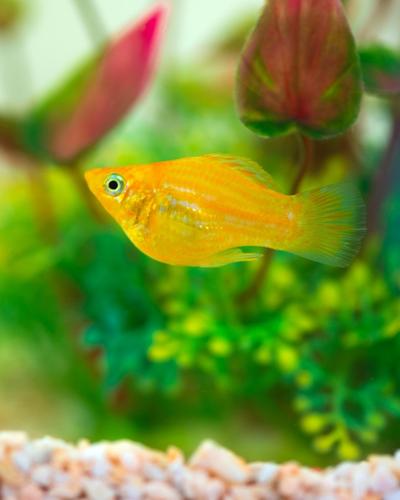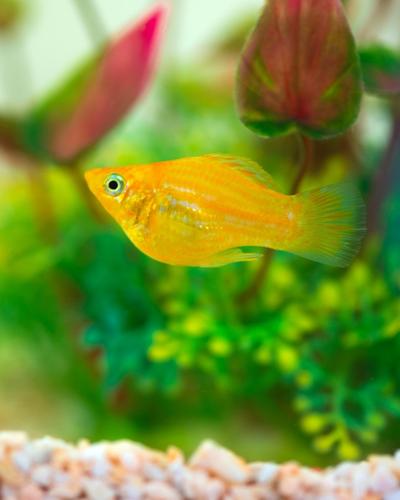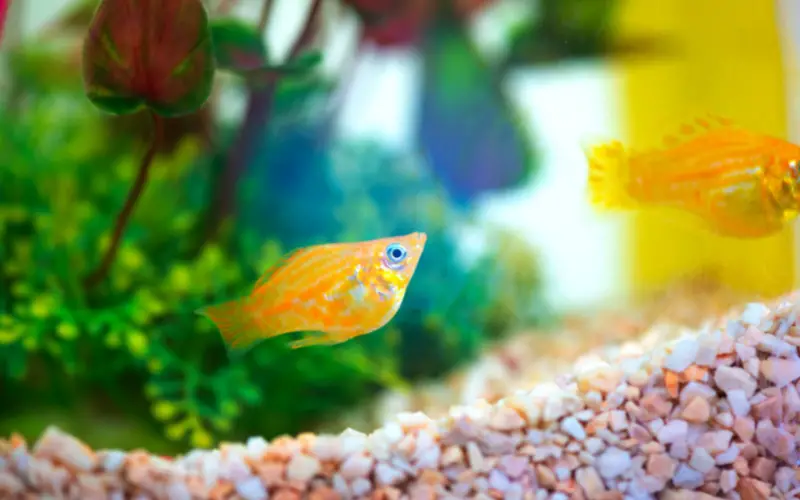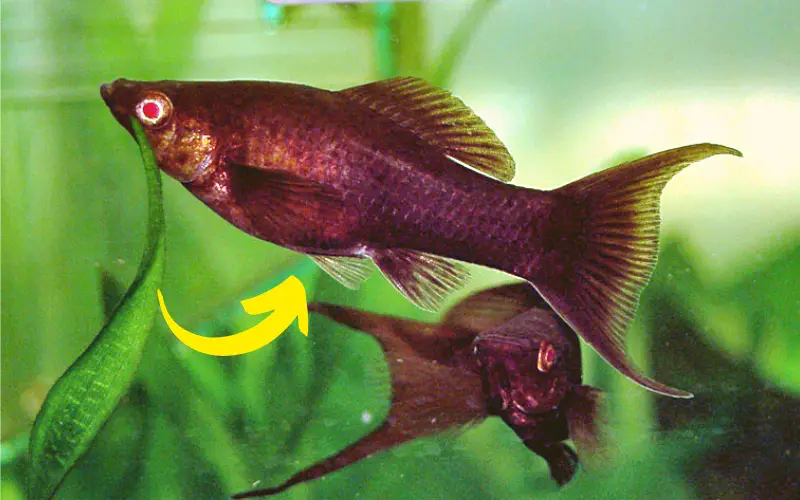Have you noticed a bloated Molly fish in your aquarium and wondered if it might be a sign of something serious? Bloating in Molly fish can often signal the onset of dropsy, a condition that can be fatal if left untreated.
Recognizing the early warning signs is essential for timely intervention and improving your fish’s chances of recovery.
In this post, we’ll explore three critical early indicators of dropsy so you can take quick action before the condition progresses. From visible bloating to subtle behavioral changes, each sign gives clues that something may be wrong.

Understanding these early symptoms can make all the difference in keeping your Molly fish healthy and thriving. Ready to learn how to protect your fish and prevent dropsy from taking hold?
Let’s dive in and discover what to watch for, so you can provide the best care for your Molly fish.
Table of Contents
ToggleWhy Is My Molly Fish So Bloated?
Why does my fish belly look bloated? It’s a valid question that many pet fish keepers ask when they first see the condition.
The answer is simple, its Dropsy: Dropsy is an internal disorder caused by gram negative bacteria or parasites.
It leads to a buildup of fluids in your fish’s body cavity and causes its abdomen to swell.
Domestic herbivorous fish can often suffer from constipation due to a lack of green fish foods in their diets.

However, it is essential to note that this disorder may be misdiagnosed as Dropsy – a severe condition requiring immediate attention.
This is why bloated stomach fish are often referred to as having “dropsy.”
Early Warning Signs of Dropsy in Molly fish
Here are three early Fish Malawi bloat Symptoms that you should look for if you think your fish may have Dropsy:
1. Swollen Abdomen: Molly fish big belly
The most apparent sign of Dropsy is the molly fish swollen belly abdomen, which can be caused by a buildup of fluid in the body cavity. Look closely for a pinched or “concave” appearance to the fish’s scales, as this is a telltale sign that they have Dropsy.
2. Loss of Appetite
One symptom you may notice in your Molly Fish is a loss of appetite. This can be caused by the inability to eat due to the swelling of their abdomen or simply due to a lack of energy due to illness.
3. Clamped Fins
Clamped fins are another sign that your fish may have Dropsy and indicate poor health. This occurs when your Molly Fish’s fins fold back against its body to conserve energy or protect themselves from further harm.
If you notice any of these signs in your Molly Fish, it’s essential to take action as soon as possible and seek professional help from your local fish vet. They can diagnose the condition and suggest a suitable treatment plan to help your fish recover.
Diagnosing Dropsy in Fish “Bloated Molly Fish”
If you notice drops on any fish, you should contact a veterinarian. Your fish will recover faster with the correct diagnosis and treatment when the problem starts.
Your doctor may evaluate the aquatic fish’s health and the clean water environment, including water quality testing.
Low water quality illness is a common cause of dropped health. How can one measure the water’s quality quickly in a way that helps them stay healthy and prevent dropsy stress from affecting their fish?
How Do You Treat Sick Fish Bloat? (Bloated Fish Cure)
Fish bloat is a common problem caused by many things, including overeating, poor water conditions, or stress.
If your fish is bloated, it can be very uncomfortable for them and can even lead to death. This molly fish video will show you two ways to cure fish bloat quickly and easily.
How Do You Treat Dropsy in Molly? Treating Dropsy in Fish is not easy, and it requires a combination of medications, aquarium salt bath, environmental changes, and proper nutrition.
It’s important to note that there is no one-size-fits-all approach to treating Dropsy in Fish; Dropsy in Fish Treatment must be tailored to the individual fish and the severity of their condition.
To ensure the ideal osmotic balance of healthy fish, adding a pinch of salt to their tank water can be highly beneficial. An increase in salinity similar to that found within its bloodstream allows them to thrive comfortably!
Fish’s blood salinity and pH levels can also be adjusted to help the fish fight off Dropsy, as well as proper nutrition to aid their recovery.
Causes of Dropsy in Molly Aquarium Fish
Dropsy in molly fish can be caused by several things, including bacteria, parasites, poor water quality, and even a bad diet.
It is crucial to identify the underlying cause of dropsy in mollies before attempting to cure it, as this will determine the type of treatment used and its effectiveness.
Dropsy in Molly Fish can be a severe condition that requires immediate attention. It’s essential to recognize the early warning signs of Dropsy so that you can take action and get your fish the help they need right away.
By providing the right environment, diet, Epsom salt, and medications, you can help ensure that your Molly Fish recovers quickly and thoroughly from Dropsy. With proper care, your fish should return to normal in no time!
Effects of Dropsy
Tell me the effect Dropsy has on the fish in our diet if it doesn’t affect them. Those with the fish diseases can suffer a skin condition. Simultaneously fish’s belly dries up in liquid and swells.

This swelling can cause severe damage to fish’s internal organs, such as the lungs. The result is anemia in fish, and the skin becomes dark.
As the fish fills its belly with liquid, the organs move toward the side, which can cause spinal damage. The swelling of the abdomen causes the fish’s scales to rise off the surface of the animal and give the animal the appearance of a pine cone.
What to Do If Fish Bloated After Water Change?
If your molly bloated stomach after a water change, you first need to check the water parameters. If anything has changed significantly—such as pH, ammonia levels, or temperature—it could be causing your fish’s bloating.
Make sure all your fish are back to normal before considering other causes of bloat.
Next, you’ll want to address any environmental changes that could have happened when you changed the water.
Has there been excess stress because of changes in decoration or tank mates? Stress can make fish more susceptible to illness and injury.
Too much waste in their environment can also cause bloating by interfering with oxygenation and digestion for your fish’s digestive system.
Once those two points have been addressed and ruled out as potential problems, consider other factors contributing to bloating, like diet-related issues or infections due to parasites (which can often be seen with a microscope).
It would be best to look for signs such as weight loss despite an increased appetite or discoloration on their fins or body, which might indicate a parasite infestation.
Lastly, none of these possible causes seems likely for your molly bloated stomach state. In that case, it could be an unbalanced aquarium where some nutrient levels may not be appropriate for the type of fish kept in that particular hospital tank – this could include too many phosphates due to overfeeding, etc.
To tackle this issue, use Aquarium test kits daily/weekly, depending on how active you are with feeding your molly fish. Having a balanced diet rich in foods high in essential fatty acids might help reduce bloating while maintaining the overall health of aquatic fish’s life (fishes) in general.
Is Fish Bloat Contagious?
Fish bloat is a condition that can affect the health of aquarium fish and can be pretty dangerous.
Aquarium owners must familiarize themselves with this condition, as it can signify several serious illnesses.
The good news is that molly fish dropsy, the leading cause of bloat, is not contagious – meaning it cannot be spread between fish in an aquarium.
This means that if one fish in the tank has Dropsy, the other fish are not in danger of catching it.
However, depending on what caused dropsy in mollies, other sick fish illnesses may still be present in the fish tanks. Therefore, if your fish showing signs of bloat in your fish, it’s crucial to take measures to protect your entire tank’s population.
What Can I Feed My Fish with Bloat?
When a fish suffering from bloat, it’s essential to feed them fish that is easy to digest. High-quality, low-fat foods like chopped frozen vegetables, cooked peas, and other soft-shelled proteins (e.g., krill) are all good options.
You should also avoid feeding them high-fat foods such as shrimp pellets or meaty meals, as these can be difficult to digest and worsen the bloat.
It’s also important to feed your fish smaller amounts multiple times a day, as this will help them digest their food more effectively and reduce the risk of further bloating.
Finally, keeping an eye on your fish’s weight and appetite is essential, as these can be signs of a more significant health issue.
Can a Fish Recover from Dropsy?
Unfortunately, fish affected by Dropsy (a condition caused by excessively high body fluid levels) does not have an excellent prognosis.
It can be challenging to diagnose and treat Dropsy with any degree of success because it is usually a symptom of an underlying health issue that needs to be addressed first.
Therefore, the best way to approach treatment is through preventative measures such as regular water changes and monitoring nitrogen levels – this will help reduce the risk of Dropsy reoccurring in other fish.
If Dropsy does develop, it is important to quarantine the affected fish from other tankmates and find out if any underlying causes can be treated directly.
While some treatments may help relieve symptoms temporarily, which may give your fish some temporary relief from its discomfort, they often cannot cure Dropsy. As such, the recovery rate for affected fish tends to be low.
Why Does My Fish Have a Fat Belly?
Why Is My Fish’s Stomach Bloated? When it comes to fish, a bloated fish stomach is usually a sign of something being off in the tank.
The most common cause of bloating is overfeeding. Too much flake food can lead to the buildup of gas bubbles in the stomach, which gives it a bloated appearance. Other possible causes include constipation, kidney failure, or internal bacterial infection.
Suppose you notice a bloated stomach in your fish. In that case, observing them for any additional signs of illness, such as lethargy, loss of appetite, or changes in their behavior, is essential.
If you do notice any of these signs, it is essential to get your fish checked out by a vet as soon as possible.
Will Molly Fish Dropsy Go Away on Its Own?
Unfortunately, Dropsy in molly fish is not likely to go away on its own. Various underlying illnesses and conditions can cause this condition, and it is crucial to figure out the cause to treat it functioning properly.
If Dropsy is left untreated, it can lead to serious health complications and even death. Therefore, it is vital to take action as soon as you notice signs of molly fish dropsy.
It is also important to take preventative measures such as regular water changes and monitoring nitrogen levels to reduce the risk of Dropsy reoccurring in your tank.
If your fish may suffer from Dropsy, you must consult a vet as soon as possible to get the proper diagnosis and treatment.
What Causes a Fish to Swell Up?
A few different potential causes can lead to a fish swelling up. The most common cause is an infection, either bacterial or fungal, which can cause inflammation in the tissues.
Other potential causes of swelling include constipation, nutritional deficiencies, a parasitic infection, or a reaction to certain medications. In some cases, it can also be caused by physical trauma, such as being hit by an object in the tank.
If you notice your fish swelling up, a vet must check it out as soon as possible to get the proper diagnosis and treatment.
Is My Molly Fish Fat or Pregnant?
Why is my molly fish so fat? is my molly pregnant or bloated? It can be difficult to tell whether your molly fish is fat or pregnant, as the two conditions can share similar symptoms. To determine for sure, you’ll need to pay close attention to the shape and size of your fish’s abdomen.
A female fish full of eggs will have a noticeably distended bloated fish belly; the abdomen should appear swollen with a pear-like shape. If there are no signs of eggs in her body, she may carry excess fat instead.
To identify this, look closely at her body, examine any changes in her pattern or coloration, and check for bloating around her abdominal area.
In addition to a physical examination, it is essential to monitor Molly’s behavior over time. If she has been lazing around more than usual or spending time alone away from other fish in the fish tank, then there’s a good chance she’s expecting!
That said, it could also be due to other underlying issues such as illness or stress, so always ensure that all water parameters remain optimal and that she gets enough rest and nutrition before making any assumptions about pregnancy.
How do I know if my molly fish is pregnant?
Fish bloat or pregnant belly can be tricky to diagnose, especially in molly fish, as they don’t have the same reproductive characteristics as some other species. However, there are a few telltale signs that you can look for to determine if your Molly is pregnant.

With the successful insemination of your Molly, you can keep an eye out for her pregnancy signs. These may include a rounder belly line, increased protectiveness or aggressive behavior towards other fishes, and taking refuge in secluded areas within the bottom of the tank.
Also, look out for darkening gravid spots signaling that fish healthy eggs are ready to be hatched soon!
How Long Are Balloon Molly Fish Pregnant For?
On average, balloon molly fish will be pregnant for approximately two months. This is the approximate time frame for a female molly fish to carry her eggs from conception to hatching.
During the 60-day gestation period of a Balloon Molly, expectant mothers will experience remarkable physical and behavioral transformations. These changes lead to living fries being welcomed into the world with open fins!
Why Do Fish Get Bloated and Died?
why is my molly fish bloated? Fish died bloated stomach is usually a sign of an underlying health issue. Bloating can be caused by several different things, such as bacterial or fungal infections, constipation, nutritional deficiencies, a parasitic infection, or a reaction to certain medications.
If you notice your fish is bloated and not responding to treatment, you must seek medical care from a vet as soon as possible to get the proper diagnosis and treatment.
Conclusion
So. why does my molly have a big belly? Here are three early warning signs of Dropsy in molly fish to watch out for: bloating, bulging eyes, and clamped fins. If you see any of these symptoms in your molly fish, immediately take action by quarantining the affected fish and seeking professional advice. With prompt treatment, your molly fish bloated stomach can fully recover.
You might also like
- Where Do Mollies Swim in the Tank? (7 Sick Fish Signs & Cure)
- Male and Female Molly Fish: 6 Ways to Identify Mollies Gender
- Mollies Fish Pregnant: Overall Care Guide & (5 Breed fish Tips)
- Do Mollies Need an aquarium Heater? Let’s Clear Up All the Confusion!
- Can Mollies Eat Tropical Fish Food? (7 Best Molly Fish Food)
- Are Mollies Schooling Fish? (9 Compatible Mollies Tank Mates)




